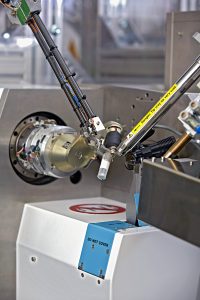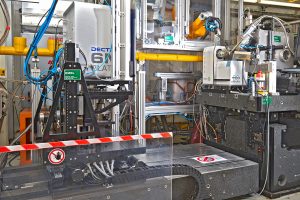P13 parameters as of 13 Sep 2021

- Beam: P13 offers micro-beam conditions with a beam size of 30 x 20 micron2 (H x V) and divergence below 0.15 mrad. Typical crystal lifetimes are <1 min. for the focused beam (5 x 1012 ph/sec at 12 keV). By adjusting the shape of the adaptive KB-mirrors, the full beam can be defocused to a size of 150 x 70 µm2 at the sample position. Apertures can be used to collimate the beam down to a diameter of 10 micron.
- Energy tunability: The beamline is tunable between 4.5 and 17.5 keV (2.7 Å to 0.7 Å).
- Low energy: At 5 keV, the total flux is higher than 2 x 1012 ph/sec. Fluorescence spectra can be recorded with a AmpTek silicon drift detector. For data collection at energies lower than 5.5 keV, a Helium cone is available. Please contact your local contact if you intend to collect data at lower than 5.5 keV.
- Diffractometer: The diffractometer is an MD2 instrument including a mini-kappa goniostat. The horizontal spindle-axis has a sphere of confusion of less than 2 micron when the mini-kappa goniostat is mounted. Three-click centering and 4D-scans are available.
- Detector: EIGER 16M (133 Hz, 750 Hz in 4M ROI mode).
- User Interface: The user interacts with the beamline via the Hamburg version of mxCuBE v2 user interface.
- Sample mounting: Crystals can be mounted manually. A MARVIN robot for mounting SPINE pins from a large capacity storage dewar (170 samples) is available; cycle time between two crystals is < 1 min.
- Data processing: 1144 core cluster is available for online data processing with XDS, EDNA fast processing and autoPROC. DIALS and XIA2 are installed.
- Data storage and archiving: Diffraction images are stored on a fast petabyte cluster storage system in gzip-compressed mini-cbf format. Instructions on how to download your data can be found on the data backup page.
- Structure determination: The autoRickshaw and hkl2map pipelines for structure solution are available.
- Ancillary facilities: A lab specifically designed and equipped for preparing derivatized crystals is accessible upon request. 42 elements in 150 compounds are available.
Typical experiments presently possible

- Collection of native data on crystals with minimum dimension of 20 micron.
- Maximum resolution achievable: 1.1 Å at detector edge using 17 keV radiation.
- Collection of highly redundant anomalous data using different kappa settings.
- Crystal characterization with beam sizes between 15 and 100 micron.
- Typical duration of a full data collection: 30 sec (to reach lifetime limit of crystal).
- Low-energy, long wavelength data collection with He-cone down to 4.5 keV upon request.
- Full MAD-phasing capability.
How to reference P13
The use of the EMBL beamlines must be acknowledged in all publications or presentations arising from data collection at the EMBL Hamburg unit. The following note is expected to appear in the acknowledgements, giving reference to the station(s) used, supporting beamline staff or any other assistance or information as appropriate, e.g. EU contract numbers, proposal numbers.
The synchrotron data was collected at beamline operated by EMBL Hamburg at the PETRA III storage ring (DESY, Hamburg, Germany). We would like to thank N.N.** for the assistance in using the beamline.
**If appropriate, names of the beamline staff in case they are not co-authors.In case of P13, please cite the beamline paper:
Cianci, Bourenkov, Pompidor et al. J.Synchr.Rad. 24:323-332 (OPEN ACCESS)
Contact
Beamline Scientist
Gleb Bourenkov
Tel: +49 (0) 40 89902-120
Email: gleb@embl-hamburg.de
MX@PETRA3 coordinator
Thomas R. Schneider
Tel.:+49 (0) 40 89902-111